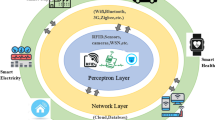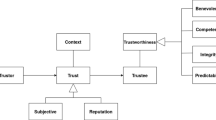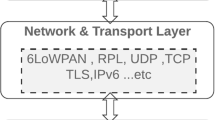Abstract
The exposure of IoT nodes to the internet makes them vulnerable to malicious attacks and failures. These failures affect the survivability, integrity, and connectivity of the network. Thus, the detection and elimination of attacks in a timely manner become an important factor to maintain network connectivity. Trust-based techniques are used in understanding the behavior of nodes in the network. The proposed conventional trust models are power-hungry and demand large storage space. Succeeding this Hidden Markov Models have also been developed to calculate trust but the survivability of the network achieved from them is low. To improve survivability, selfish and malicious nodes present in the network are required to be treated separately. Hence, in this paper, an improved Hidden Markov Trust (HMT) model is developed, which accurately detects the selfish and malicious nodes that illegally intercept the network. The proposed model comprises the Learning Module which aims to understand the behavior of nodes and compute trust using HMT with the expected output. The probability parameters of the HMT model are derived from the data flow rate and the residual energy of the nodes. Next, in Decision-Module, the actual nature of the node is obtained with the help of the evaluated node’s likelihood functions. If the node is selfish and is close to crashed state then, is isolated from the routing function, while the selfish node with sufficient energy is immediately destroyed from the network. On the other hand, malicious nodes are provided with a time-based opportunity to reset themselves before being knocked down. Finally, if the node is legitimate, then the function continues smoothly. At last, the Path-Formation-Module establishes the trusted optimal routing path. Further, comparative analysis for attacks such as black-hole, grey-hole, and sink-hole has been done and performance parameters have been extended to survivability-rate, power consumption, delay, and false-alarm-rate, for different network sizes and vulnerability. Simulation result on average provides a 10% higher PDR, 29% lower overhead, and 17% higher detection rate when compared to a Futuristic Cooperation Evaluation Model, Futuristic Trust Coefficient-based Semi-Markov Prediction Model, Opportunistic Data Forwarding Mechanism, and Priority-based Trust Efficient Routing using Ant Colony Optimization trust models presented in the literature.


*Note: ‘#’ represents ‘the number of’








Similar content being viewed by others
References
Dehury, C. K., & Sahoo, P. K. (2016). Design and implementation of a novel service management framework for IoT devices in cloud. Journal of Systems and Software, 119, 149–161. https://doi.org/10.1016/j.jss.2016.06.059
Abosata, N., Al-Rubaye, S., Inalhan, G., & Emmanouilidis, C. (2021). Internet of Things for system integrity: A comprehensive survey on security, attacks and countermeasures for industrial applications. Sensors, 21(11), 3654. https://doi.org/10.3390/s21113654
Akhtar, A. K., & Sahoo, G. (2012). Mathematical model for the detection of selfish nodes in MANETs. International Journal of Computer Science and Informatics, 5(3), 25–28.
Rahim, M. A., Rahman, M. A., Rahman, M. M., Asyhari, A. T., Bhuiyan, M. Z. A., & Ramasamy, D. (2021). Evolution of IoT-enabled connectivity and applications in automotive industry: A review. Vehicular Communications, 27, 100285. https://doi.org/10.1016/j.vehcom.2020.100285
Ávila, K., Sanmartin, P., Jabba, D., & Gómez, J. (2022). An analytical survey of attack scenario parameters on the techniques of attack mitigation in WSN. Wireless Personal Communications, 122(4), 3687–3718. https://doi.org/10.1007/s11277-021-09107-6
Sobral, J. V. V., Rodrigues, J. J. P. C., Rabêlo, R. A. L., Saleem, K., & Furtado, V. (2019). LOADng-IoT: An enhanced routing protocol for internet of things applications over low power networks. Sensors, 19(1), 150. https://doi.org/10.3390/s19010150
Gonçalves, A. J. R., Rabêlo, R. A. L., Rodrigues, J. J. P. C., & Oliveira, L. M. L. (2020). A mobility solution for low power and lossy networks using the LOADng protocol. Transactions on Emerging Telecommunications Technologies, 31(12), 1–24. https://doi.org/10.1002/ett.3878
Shukla, M., Joshi, B. K., & Singh, U. (2021). Mitigate wormhole attack and blackhole attack using elliptic curve cryptography in MANET. Wireless Personal Communications, 121(1), 503–526. https://doi.org/10.1007/s11277-021-08647-1
Anand, C., & Vasuki, N. (2021). Trust based DoS attack detection in wireless sensor networks for reliable data transmission. Wireless Personal Communications, 121(4), 2911–2926. https://doi.org/10.1007/s11277-021-08855-9
Narayana, S. K., & Hosur, N. T. (2022). Priority based trust efficient routing using ant colony optimization for IoT-based mobile wireless mesh networks. International Journal of Intelligent Engineering and Systems, 15(2), 99–106. https://doi.org/10.22266/ijies2022.0430.10
Zhongqiu, J., Shu, Y., & Liangmin, W. (2009). Survivability Evaluation of Cluster-Based Wireless Sensor Network under DoS Attack. In 2009 5th International Conference on Wireless Communications, Networking and Mobile Computing. https://doi.org/10.1007/978-3-642-32427-7_18
Theerthagiri, P. (2020). FUCEM: Futuristic cooperation evaluation model using Markov process for evaluating node reliability and link stability in mobile ad hoc network. Wireless Networks, 26(6), 4173–4188. https://doi.org/10.1007/s11276-020-02326-y
Maragatharajan, M., Balasubramanian, C., & Balakannan, S. P. (2019). A secured MANET using position-based opportunistic routing and SEMI MARKOV process. Concurrency and Computation: Practice and Experience, Wiley, 31(14), 1–8. https://doi.org/10.1002/cpe.5047
Chen, L., Thombre, S., Jarvinen, K., Lohan, E. S., Alen-Savikko, A., Leppakoski, H., & Kuusniemi, H. (2017). Robustness, security and privacy in location-based services for future IoT: A survey. IEEE Access, 5, 8956–8977. https://doi.org/10.1109/ACCESS.2017.2695525
Peng, S., Wu, M., Wang, G., & Yu, S. (2014). Propagation model of smartphone worms based on semi-Markov process and social relationship graph. Computers & Security, 44, 92–103. https://doi.org/10.1016/j.cose.2014.04.006
Sengathir, J., & Manoharan, R. (2015). A futuristic trust coefficient-based semi-Markov prediction model for mitigating selfish nodes in MANETs. EURASIP Journal on Wireless Communications and Networking, 2015(1), 158. https://doi.org/10.1186/s13638-015-0384-4
Liu, X., & Datta, A. (2012). Modeling context aware dynamic trust using hidden markov model. In Proceedings of the National Conference on Artificial Intelligence (Vol. 3, pp. 1938–1944).
Pathak, P., Chauhan, E., Rathi, S., & Kosti, S. (2018). HMM-Based IDS for Attack Detection and Prevention in MANET. In Lecture Notes in Networks and Systems (Vol. 10, pp. 413–421). https://doi.org/10.1007/978-981-10-3920-1_42
Alam, M. M., Sajid, M. S. I., Wang, W., & Wei, J. (2022). IoTMonitor: A Hidden Markov Model-based Security System to Identify Crucial Attack Nodes in Trigger-action IoT Platforms. In 2022 IEEE Wireless Communications and Networking Conference (WCNC) (pp. 1695–1700). IEEE. https://doi.org/10.1109/WCNC51071.2022.9771878
Zhang, X., Wu, T., Zheng, Q., Zhai, L., Hu, H., Yin, W., & Cheng, C. (2022). Multi-step attack detection based on pre-trained hidden Markov models. Sensors, 22(8), 2874. https://doi.org/10.3390/s22082874
Khan, M. A., & Abuhasel, K. A. (2021). An evolutionary multi-hidden Markov model for intelligent threat sensing in industrial internet of things. The Journal of Supercomputing, 77(6), 6236–6250. https://doi.org/10.1007/s11227-020-03513-6
Chen, C.-M., Guan, D.-J., Huang, Y.-Z., & Ou, Y.-H. (2016). Anomaly network intrusion detection using hidden Markov model. In International Journal of Innovative Computing, Information and Control (pp. 569–580).
Wu, D., Zhang, F., Wang, H., & Wang, R. (2018). Security-oriented opportunistic data forwarding in Mobile Social Networks. Future Generation Computer Systems, 87, 803–815. https://doi.org/10.1016/j.future.2017.07.028
Li, T., Liu, Y., Liu, Y., Xiao, Y., & Nguyen, N. A. (2020). Attack plan recognition using hidden Markov and probabilistic inference. Computers & Security, 97, 101974. https://doi.org/10.1016/j.cose.2020.101974
Liu, H., Han, D., & Li, D. (2021). Behavior analysis and blockchain based trust management in VANETs. Journal of Parallel and Distributed Computing, 151, 61–69. https://doi.org/10.1016/j.jpdc.2021.02.011
Ingale, S., Paraye, M., & Ambawade, D. (2020). Enhancing Multi-Step Attack Prediction using Hidden Markov Model and Naive Bayes. In 2020 International Conference on Electronics and Sustainable Communication Systems (ICESC) (pp. 36–44). IEEE. https://doi.org/10.1109/ICESC48915.2020.9155895
Kalnoor, G., & Gowri Shankar, S. (2022). A model-based system for intrusion detection using novel technique-hidden Markov Bayesian in wireless sensor network. In Proceedings of Third International Conference on ICTCS 2017 (Vol. 40, pp. 43–53). https://doi.org/10.1007/978-981-16-0739-4_4
Muhati, E., & Rawat, D. B. (2022). Hidden-Markov-model-enabled prediction and visualization of cyber agility in IoT era. IEEE Internet of Things Journal, 9(12), 9117–9127. https://doi.org/10.1109/JIOT.2021.3056118
Roles, A., & ElAarag, H. (2017). Coexistence with malicious and selfish nodes in wireless ad hoc networks: A Bayesian game approach. Journal of Algorithms & Computational Technology, 11(4), 353–365. https://doi.org/10.1177/1748301817725305
Daniel Jurafsky, J. H. M. (2019). Hidden Markov Models. In Speech and Language Processing (3rd ed. draft) (Vol. 16, pp. 795–796).
Mor, B., Garhwal, S., & Kumar, A. (2021). A systematic review of hidden Markov models and their applications. Archives of Computational Methods in Engineering, 28(3), 1429–1448. https://doi.org/10.1007/s11831-020-09422-4
Author information
Authors and Affiliations
Corresponding author
Ethics declarations
Conflicts of interest
The authors declare that they have no known competing financial interests or personal relationships that could have appeared to influence the work reported in this paper.
Additional information
Publisher's Note
Springer Nature remains neutral with regard to jurisdictional claims in published maps and institutional affiliations.
Rights and permissions
Springer Nature or its licensor holds exclusive rights to this article under a publishing agreement with the author(s) or other rightsholder(s); author self-archiving of the accepted manuscript version of this article is solely governed by the terms of such publishing agreement and applicable law.
About this article
Cite this article
Joshi, G., Sharma, V. Hidden Markov Trust for Attenuation of Selfish and Malicious Nodes in the IoT Network. Wireless Pers Commun 128, 1437–1469 (2023). https://doi.org/10.1007/s11277-022-10007-6
Accepted:
Published:
Issue Date:
DOI: https://doi.org/10.1007/s11277-022-10007-6




